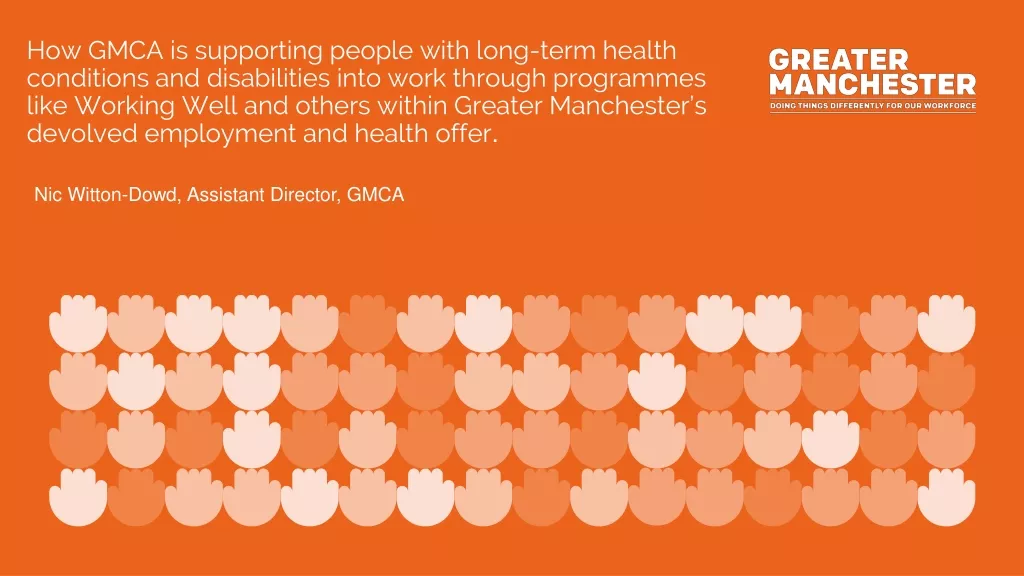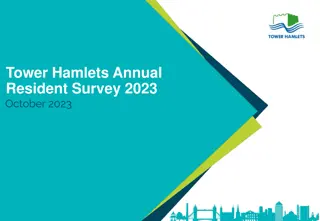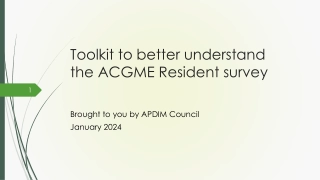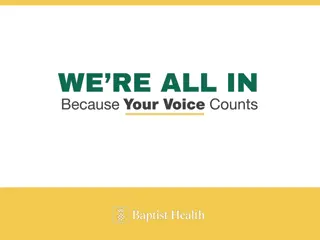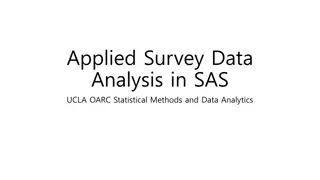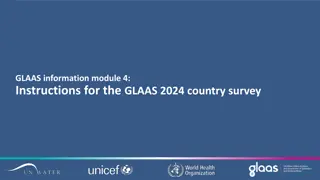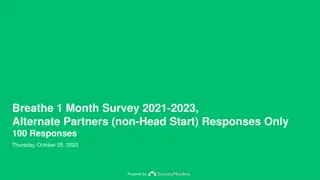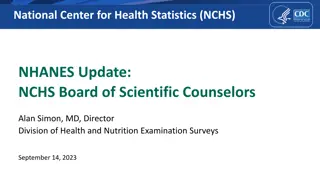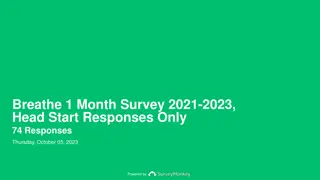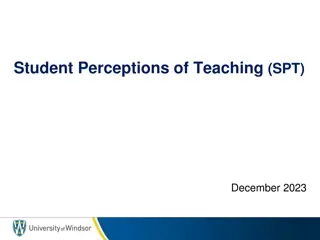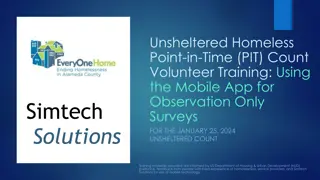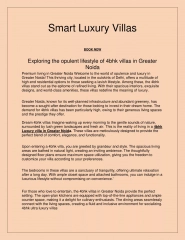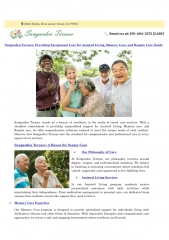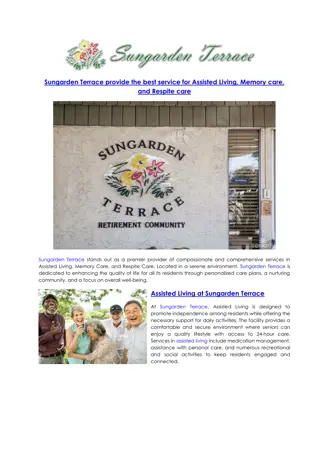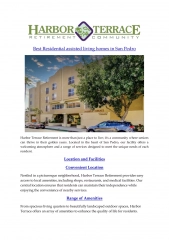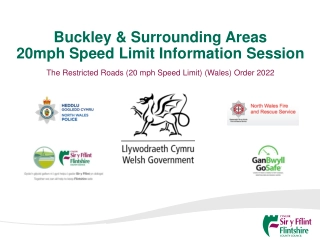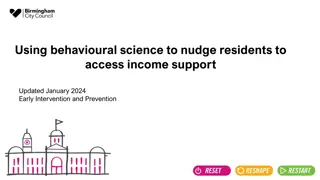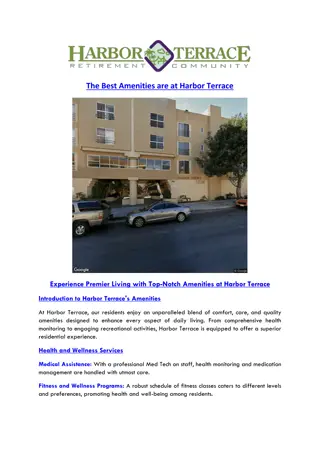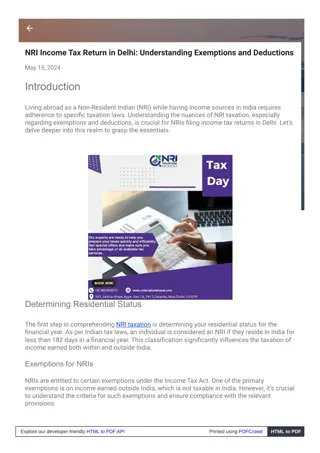Greater Manchester Residents’ Survey
This report presents summary findings of a quantitative survey conducted in Greater Manchester between 29th January and 13th February 2024. The survey included 1,460 residents from all ten local authority areas. Data from this survey, alongside previous ones, offers insights into health, wellbeing, living conditions, work, transport, and digital inclusion. The aim is to provide valuable information for organizations and partners to enhance the lives of Greater Manchester residents.
Greater Manchester Residents’ Survey
PowerPoint presentation about 'Greater Manchester Residents’ Survey'. This presentation describes the topic on This report presents summary findings of a quantitative survey conducted in Greater Manchester between 29th January and 13th February 2024. The survey included 1,460 residents from all ten local authority areas. Data from this survey, alongside previous ones, offers insights into health, wellbeing, living conditions, work, transport, and digital inclusion. The aim is to provide valuable information for organizations and partners to enhance the lives of Greater Manchester residents.. Download this presentation absolutely free.
Presentation Transcript
Greater Manchester Residents Survey Survey 11 (main report) March 2024 Fieldwork conducted 29th January 13th February 2024
Report contents 3 Introduction 7 Health and wellbeing 20 Healthy homes 32 Local area 45 Transport and night-time economy 53 Good work 61 Cost of living 80 Digital inclusion 92 Local Authority summaries 103 Appendix
Introduction and methodology Background Methodology Report contents and guidance page 4 page 5 page 6 3
Background This report presents summary findings for a quantitative survey carried out between 29 January and 13 February 2024, with a representative sample of 1,460 residents from across all ten Greater Manchester local authority areas. Data from February 2024 (survey 11) is presented alongside that from similar Greater Manchester resident surveys undertaken in September 2023 (survey 9) and November 2023 (survey 10). To provide a national comparison, where available, Greater Manchester findings are presented alongside the most recent benchmarking data from relevant national surveys for example, published figures from the Office for National Statistics (ONS) In presenting Greater Manchester data, results from surveys 9, 10 and 11 have been merged where appropriate. This allows for larger and therefore more stable and robust sample sizes for analysis into specific sub-groups within the overall population over a longer period. The following approaches have been used, as felt most appropriate for the datasets in each theme: health and wellbeing data from individual surveys is shown separately healthy homes merged data from surveys 10 and 11 is shown (questions were first included in survey 10) local area data from individual surveys is shown separately, except when commenting on trends for specific sub-groups or districts transport and the night time economy new section, so data from survey 11 only is shown good work data from individual surveys is shown separately, except when commenting on trends for specific sub-groups or districts cost of living data from individual surveys is shown separately digital inclusion merged data for surveys 9+10+11 is used, drawing on telephone responses only These surveys are intended to provide regular ongoing insights for Greater Manchester organisations and partners to help inform how and where to target support, communications / engagement activities and resources to improve the lives of Greater Manchester residents. 4
Methodology Between February 2022 and February 2024, BMG Research has undertaken eleven surveys, each comprising circa 1,500 residents from across Greater Manchester. Each sample has included around: 750 online panel respondents 250 telephone respondents, and 500 online river sampled respondents (those who responded to adverts, offers and invitations to take part in the surveys) This mix of majority online sampling with a smaller telephone element was selected so that a representative and robust sample of Greater Manchester residents could be regularly sourced within available time and budget. The telephone element was included so that those without internet access could take part in the survey. This was particularly important for the questions on digital inclusion. However, readers should be aware that insights based on the telephone-only data are less robust because of the smaller base size; we have sought to overcome this by merging findings from multiple consecutive surveys. Each survey is designed to take 15 minutes on average for respondents to complete; however, due to the emotive nature of some topics covered, interviews by telephone tend to take longer than this. Quotas are set to ensure the sample broadly reflects the profile of Greater Manchester s population by gender, age, ethnicity and disability, with further consideration of wider protected and key characteristics. Weights have been applied to the data gathered to ensure the sample matches the population profile by age, gender, ethnicity, disability and locality, and to ensure consistency between individual surveys. 5
Report contents and guidance This survey 11 report presents a range of tables and charts with accompanying narrative to highlight the key findings from each section of the survey among the sample (1,460 respondents). These are presented alongside findings for surveys 9 (1,560 respondents) and 10 (1,546). See the Appendix for full details on the sample achieved in each round of fieldwork. The report is divided into themed sections, providing an overview into respondents feelings and behaviours around personal health and wellbeing, healthy homes, satisfaction with their local area, transport and the night-time economy, good work, costs of living and digital access. Where relevant, differences in findings for specific demographic and other population characteristics compared to the Greater Manchester average are also reported. These differences are only highlighted where they are significantly different statistically (at the 95% level of confidence) compared with the total figures (i.e. the Greater Manchester average). Significant differences are shown in charts and tables with the use of up and down arrows. Further detail on significance testing can be found in the Appendix of this report. On some questions, it should be noted that responses have been filtered only to include respondents to whom the question is relevant (e.g. those in work, or with children), and so bases are lower than the full sample of 1,460 respondents in some instances. Where this is the case, this has been noted in the footnotes of each slide, along with the unweighted base sizes. Finally, and with regards to a key point of language, it should be noted that this report uses the term from within racially minoritised communities to refer to people and communities experiencing racial inequality (the term recognises that individuals have been minoritised through social processes rather than just existing as distinct minorities, although it is important to acknowledge the negative consequence of grouping all minoritised individuals together under one term, as there are significant differences both between and within these groups. From within has been added to recognise that not all in these communities will identify as minoritised). Due to limitations of sample size, we are generally unable to report findings from individual surveys for specific ethnic groups. However, where data is merged from multiple surveys over several months, the larger overall sample size allows us to look at smaller demographic groups in more detail. Any such differences are included throughout this report. 6
Health and wellbeing Overview and context Health and wellbeing key findings Health and wellbeing detailed findings page 8 page 9 pages 10-20
Health and wellbeing context The Greater Manchester Residents' Survey investigates the four measures of personal wellbeing commonly asked in national surveys life satisfaction, anxiety, happiness and feelings that things done in life are worthwhile. Up until April 2023 (survey 6), due to survey time constraints, questions were asked only on the first two of these measures; changes across the survey have more recently allowed us to make capacity for exploring wellbeing in broader terms. As this is now the fifth time that we have asked all four questions, findings in relation to wellbeing are becoming more robust at different spatial levels and for different sub-groups. The wellbeing questions used are replicated from the Annual Population Survey. These are nationally recognised metrics, used in their current form since 2011. We also ask questions around people s abilities to manage their own health. This allows us to calculate and track changes over time in an overall Health Confidence Score for Greater Manchester. Questions are modelled on a published BMJ approach.
Health and wellbeing key findings WELLBEING There has been positive movement across most wellbeing metrics since November: There has been a significant increase since November in respondents reporting either 'very high' or 'high' levels of happiness (60%, was 56%). This is supported by a slight reduction in those unhappy (16%, was 18%) Two thirds (66%) of respondents say that the things they do in life are worthwhile an increase of 3pp since November Nearly two thirds (64%) of Greater Manchester respondents say they have very high or high life satisfaction, with a slight increase in those who have high satisfaction (46%, was 43% in November) Around 4 in 10 (38%) respondents said they were highly anxious yesterday a small decline since November (was 42%). Around a quarter (24%) said they were experiencing very low anxiety MANAGING YOUR OWN HEALTH There has been a significant increase in those who strongly agree that they can get the right help if they need it (30%, was 26% in November). Overall, almost three quarters (73%) of respondents agree (agree or strongly agree) that this is the case 9 in 10 (90%) respondents say that they are involved in decisions about their health, while 84% agree that they can look after their health. 4 in 5 (79%) agree that they know enough about their health. All measures have either stayed in line with or shown some positive movement since November These results combine to give an overall Health Confidence score for Greater Manchester of 71.4 representing a moderate level of health confidence. This has risen, though not significantly, since November, where the score was 70.0 DISABLED RESPONDENTS Disabled respondents are significantly more likely to respond negatively when asked about their health and wellbeing reporting a lower health confidence score (61.5, compared to 71.4 for all respondents) Generally, they feel more unhappy and anxious, and less able to manage their own health
There has been a slight increase in the proportion of respondents with high life satisfaction and slight decrease in those with medium life satisfaction since November. Taking a broader view, most ratings over time remain generally stable How satisfied are you with your life nowadays? 20% 20% 19% 18% 18% 18% 18% 16% Very high (9-10) 46% 46% High (7-8) 44% 44% 43% 43% 43% 42% 24% Medium (5-6) 23% 23% 23% 23% 22% 22% 21% 16% 16% 15% 15% 15% 14% 14% 14% Low (0-4) Nov '22 (S4) Dec '22 (S5) Mar '23 (S6) May '23 (S7) July '23 (S8) Sept '23 (S9) Nov '23 (S10) Feb '24 (S11) Significantly higher/lower than the Greater Manchester Residents Survey before 10 A1. Where 0 is not at all and 10 is completely Unweighted base: Greater Manchester Residents Survey 4, 1636; Survey 5, 1470; Survey 6, 1767, Survey 7, 1488, Survey 8, 1612, Survey 9, 1560, Survey 10, 1546, Survey 11, 1460
While measures of anxiety have continued to remain stable over the last year, since November those reporting high levels have fallen and those reporting very low levels have risen slightly. Neither change is significant, but they show positive movement How anxious did you feel yesterday? 43% 42% 42% 41% 41% 41% 40% 38% High (6-10) 19% 18% 18% 18% 18% 18% 17% 17% Medium (4-5) 20% 19% 18% 18% 18% 18% 17% 16% Low (2-3) 25% 24% 24% 24% 23% 23% 22% 20% Very low (0-1) Nov '22 (S4) Dec '22 (S5) Mar '23 (S6) May '23 (S7) July '23 (S8) Sept '23 (S9) Nov '23 (S10) Feb '24 (S11) Significantly higher/lower than the Greater Manchester Residents Survey before 11 A2. Where 0 is not at all and 10 is completely Unweighted base: Greater Manchester Residents Survey 4, 1636; Survey 5, 1470; Survey 6, 1767, Survey 7, 1488, Survey 8, 1612, Survey 9, 1560, Survey 10, 1546, Survey 11, 1460
Those who are more likely to have low levels of life satisfaction and high levels of anxiety include those in financially vulnerable situations and those with long term health conditions % who felt highly anxious compared to GM average (40%) is higher among*: % with higher levels of low life satisfaction compared to GM average (14%)*: Demographics: Those with a disability (28%) including those with mental ill health (42%), a mobility disability (23%), a learning disability (24%), or another disability (28%) Those with mixed ethnicity (29%) Those who are not heterosexual (21%) Those aged 45-54 (18%) Demographics: Those with a disability (56%) including those with mental ill health (71%), a learning disability (59%), a mobility disability (48%) or another disability (55%) Those aged 16-24 (51%) or 25-44 (46%) Those who are in a racially minoritised community (48%) Those who are not heterosexual (48%) Individual and/or family circumstance: Those with low levels of happiness (59%) Those not in work due to ill health or disability (41%) Respondents who are financially vulnerable (27%) Those with a physical or mental condition lasting longer than 12 months (24%), specifically those whose condition reduces their ability to do activities a lot (34%) Those with high anxiety (23%) Those who rent their home (21%) Those in single person households (20%) Those earning up to 15,599 (20%) Those not in employment (17%) Individual and/or family circumstance: Those with a physical or mental condition lasting longer than 12 months (51%), specifically those whose condition reduces their ability to do activities a lot (60%) Those not in work due to ill health or disability (66%) Those who are financially vulnerable (52%) Those studying at university (51%) Those earning up to 15,599 (49%) Those renting their home (49%) Those who currently have caring responsibilities (45%) Those with children in education (44%) * Subgroup analysis uses merged data from S9, 10 and 11 combined A1. Where 0 is not at all and 10 is completely A2. Where 0 is not at all and 10 is completely Unweighted base: Greater Manchester Residents Surveys 9-11, 4566
2 in 3 respondents feel very highly or highly that the things they do in life are worthwhile. But disabled respondents and those aged 16-24 are less likely to feel that this is the case To what extent are the things you do in your life worthwhile? 28% 26% % who felt that their life was not at all worthwhile compared to GM average (13%)*: Demographics: Those who have a disability (26%), including mental ill health (43%), a mobility disability (21%) Those who are not heterosexual (19%) Those aged 16-24 (19%) Individual and/or family circumstance: Those who rent their home (19%) 25% Very high (9-10) 24% 23% 41% 40% 39% 38% 38% High (7-8) 24% 22% 22% 21% 21% Medium (5-6) 15% 14% 13% 13% 12% Low (0-4) * Subgroup analysis uses merged data from S9-11 March '23 (S6) May '23 (S7) July '23 (S8) November '23 (S10) February '24 (S11) Significantly higher/lower than the Greater Manchester Residents Survey before Q10. Overall, to what extent do you feel that the things you do in your life are worthwhile, on a scale of 0 to 10, where 0 is not at all and 10 is completely ? / Unweighted base: Greater Manchester Residents Survey 6, 1767, Survey 7, 1488, Survey 8, 1612, Survey 9, 1560, Survey 10, 1546, Survey 11, 1460. Thresholds are applied to responses to convert the 11-point scale into the categories shown. Unweighted base: Greater Manchester Residents Survey 11, 1460. Survey 9+10+11= 4566 (all respondents). 13
3 in 5 said they feel very high or high levels of happiness in combination, this is a significant rise since November. Those less likely to feel happy include those with a disability and those who rent their home How happy did you feel yesterday? Very high (9-10) 24% % who did not feel at all happy yesterday, compared to the GM average (16%)*: Demographics: Those who have a disability (30%), including those with mental ill health (45%), a mobility disability (27%) or a learning disability (27%) Those aged 16-24 (20%) Individual and/or family circumstance: Those not in work due to ill health or disability (48%) Those who are renting (22%) 23% 22% 21% 20% High (7-8) 39% 38% 38% 36% 35% 26% 24% 23% 23% Medium (5-6) 22% 18% 17% 17% 17% 16% * Subgroup analysis uses merged data from S9-11 Low (0-4) March '23 (S6) May '23 (S7) July '23 (S8) November '23 (S10) February '24 (S11) Significantly higher/lower than the Greater Manchester Residents Survey before Q11. Overall, how happy did you feel yesterday, on a scale of 0 to 10, where 0 is not at all and 10 is completely ? Survey 6, 1767, Survey 7, 1488, Survey 8, 1612, Survey 9, 1560, Survey 10, 1546, Survey 11, 1460 Thresholds are applied to responses to convert the 11-point scale into the categories shown. Unweighted base: Greater Manchester Residents Survey 11, 1460. Survey 9+10+11= 4566 (all respondents). 14
The majority of respondents continue to agree that they can manage their health. While those who strongly agree that they can get the right help if they need it has significantly increased since November, the share of those agreeing more generally has not changed I am involved in decisions about me I can look after my health I know enough about my health I can get the right help if I need it 30% (+4pp) 30% (+3pp) 34% (+/-0pp) 55% (+3pp) 73% (+2pp) 79% (+2pp) 84% (+/-0pp) 90% (+1pp) 43% (-2pp) 49% (-1pp) 50% (+/-0pp) 35% (-2pp) 15% (-2pp) (-1pp) 14% (-2pp) (-1pp) 12% (+1pp) (-1pp) (+/-0pp) 9% 7% 6% 4% Strongly agree Agree Neutral Disagree Don't know Significantly higher/lower than the Greater Manchester Residents Survey before Figures in brackets show change since November (S10) S14. To what extent do you agree or disagree with the following statements? Unweighted base: All respondents Survey 11, 1460 (All responses) 15
Health confidence score Health management questions are analysed, drawing on a methodology used in academia, to calculate an overall Health Confidence Score. This score of 71.4 out of 100 means a moderate level of health confidence, marginally but not significantly up on the November 2023 figure Access 65.3 +2.0 (since Nov) I can get the right help if I need it Knowledge 67.6 +1.7 (since Nov) I know enough about my health Self-management 71.3 +0.2 (since Nov) I can look after my health Shared decision 81.2 +1.5 (since Nov) I am involved in decisions about me An overall health confidence score is calculated based on responses to four questions, each covering one of four dimensions access, knowledge, self-management, shared decisions Overall Greater Manchester health confidence score (out of 100) 71.4 This is +1.4 points higher than in Nov 2023 On a 0-100 scale, these thresholds are given the following interpretations: High 80-100 Moderate 60-79 Low 40-59 Very low 0-39 S14. To what extent do you agree or disagree with the following statements? Unweighted base: All respondents Survey 11, 1460 (Valid responses) 16
Since November, all dimensions of the health confidence score have risen, though not significantly; this includes shared decisions returning to a high rating (80 or above), having fallen to moderate in November. Overall Greater Manchester health confidence score (out of 100) Health confidence ratings: High = 80-100 / Moderate = 60-79 / Low = 40-59 / Very Low = 0-39 81.7 81.2 81.2 80.6 79.7 72.0 71.8 71.1 71.4 71.3 70.5 70.4 71.6 71.5 70.0 67.6 68.4 68.1 66.8 65.3 65.9 65.5 64.5 64 63.3 May '23 (S7) July '23 (S8) Sep '23 (S9) Nov '23 (S10) Feb '24 (S11) Overall HCS Knowledge Self-management Access Shared decisions While there has been some fluctuation in health confidence score since tracking started in May 2023, no changes have been significant. S14. To what extent do you agree or disagree with the following statements? Unweighted base: All respondents; Survey 7, 1488; Survey 8, 1612; Survey 9, 1560; Survey 10, 1546; Survey 11, 1460 17
For disabled respondents, the overall health confidence score, and the scores for each factor contributing to it, are lower than for the population as a whole; there is a particular difference in feelings of being able to 'look after my health as has been the case for several waves Access 65.3 I can get the right help if I need it Knowledge 67.6 I know enough about my health Self-management 71.3 I can look after my health Shared decisions 81.2 I am involved in decisions about me Across Greater Manchester -10.7 -5.7 -14.2 -5.3 Difference 54.6 61.9 57.1 72.3 GM disabled respondents I can get the right help if I need it I know enough about my health I can look after my health I am involved in decisions about me Overall health confidence score (out of 100) 71.4 vs. 61.5 -9.9 Greater Manchester overall Disabled respondents only S14. To what extent do you agree or disagree with the following statements? Unweighted base: Survey 1, 1460 (All responses); 346 (Disabled respondents) 18
Since May 2023, all dimensions of the health confidence score have fluctuated for disabled respondents, though 'shared decisions' has always remained highest Greater Manchester health confidence score among disabled respondents (out of 100) Health confidence ratings: High = 80-100 / Moderate = 60-79 / Low = 40-59 / Very Low = 0-39 76.4 74.0 74.4 73 72.3 63.1 62.6 61.7 61.9 60.5 63.7 60.9 61.5 61.7 58.5 57.8 60.2 57.1 57.7 57.6 56.8 54.6 54.6 52.1 May '23 (S7) 52.0 Nov '23 (S10) July '23 (S8) Sep '23 (S9) Feb '24 (S11) Overall HCS Knowledge Self-management Access Shared decisions While there has been some fluctuation in health confidence score since tracking started in May 2023, no changes have been significant. S14. To what extent do you agree or disagree with the following statements? Unweighted base: All respondents; Survey 7, 374 ; Survey 8, 417; Survey 9, 412; Survey 10, 385; Survey 11, 346 19
Healthy homes Healthy homes key findings Healthy homes topline findings pages 22-23 pages 24-33
Healthy homes experience / reporting of problems This is the second survey in which Healthy homes has been explored, to better understand residents living environments and the extent to which any problems commonly associated with poor quality housing are experienced. As a relatively new topic, results should be used to feed into broader conversations in conjunction with other datasets and engagement activity that is underway elsewhere in Greater Manchester. Results in this section are using a merged base from Surveys 10 (November 2023) and 11 (February 2024). EXPERIENCES OF PROBLEMS Almost two in three (62%) respondents have experienced a problem in their home in the last year including over 1 in 3 (36%) who are currently experiencing an issue This is significantly higher among 16-24-year-olds (72%), minority ethnic groups (76%) and those with a disability (72%) The most common issues are damp / mould (35%), broken boilers and heating (24%) and poor home insulation (19%) Renters are more likely than home owners to experience all issues asked about, except pest infestations Around 1 in 8 respondents say that they ve been worried about losing their home at some point in the last 12 months including 8% of owners and ~20% of renters REPORTING OF PROBLEMS 2 in 3 (67%) people experiencing issues with their housing have raised these; this is higher among renters (81%) Respondents are most likely to raise concerns around broken boilers and heating (68%), gas, electricity or water supply problems (61%) and broken electronics (59%). Poor or missing home insulation is least likely to be raised (42%) Across all problems, a fifth (19%) are satisfied with how their reported concerns have or are being resolved. Poor / missing home insulation is the only concern for which more than half of those who raise the issue are satisfied with its resolution (51%) o
Healthy Homes health and wellbeing / renting HEALTH & WELLBEING IMPACTS Approaching 2 in 5 (38%) of those experiencing issues say their physical or mental health or wellbeing has been largely impacted negatively as a result. This equates to 1 in 4 (24%) of everyone included in the Residents Survey. Such health / wellbeing problems are more than twice as likely to be experienced by renters than homeowners (37% vs 16%) Across the whole population, damp / mould (9%) and fear of losing their home (7%) are the issues most commonly having large health impacts Fear of losing the home (58%), home not meeting accessibility needs (39%) and poor home insulation, pest infestations and broken windows / doors (all 31%) most frequently have a large negative health / wellbeing impact on those experiencing them Fewer than a quarter of people experiencing these impacts have raised them with a GP (22%). The likelihood of raising things with a GP increases in some situations e.g. those with homes not meeting accessibility needs (and those worried about losing their home) EXPERIENCES OF RENTERS Renters are significantly more likely to have experienced an issue with their home in the past year compared to home owners (71% to 56%), and be currently experiencing an issue (48% to 30%). Issues are particularly experienced by those renting from housing associations/trusts (78%) or from local authorities/councils (74%), rather than from private landlords (68%) though all are more likely to have experienced an issue than home owners Problems with housing have been raised by 81% of renters who experienced them, compared to 58% of owners Renters (23%) are more likely than owners (16%) to be satisfied with how their issues have or are being resolved Renters (37%) are more likely than owners (16%) to say their physical or mental health has been largely impacted by housing problems o o o o o o o
Three in five respondents are currently experiencing a problem in their home or have done in the last year. Damp / mould, broken boilers and poor home insulation are the most common issues. Summary: Problem 62% 35% 24% 19% 18% 16% 13% 14% 12% 10% 5% 4% 6% 5% 6% 7% 5% 11% 5% 7% 6% 13% 8% 21% 11% 19% 8% 36% 14% 26% 87% 84% 85% 75% 83% 81% 78% 74% 62% 37% 7% 4% 4% 4% 3% 3% 3% 3% 3% 1% NET: Experienced any problem in the last year Damp / mould Broken boiler / heating / hot water Poor / missing home insulation Pest infestation Gas, electricity or water supply problems Broken windows / doors Broken electrics Fear of losing my home My home not meeting accessibility needs Yes, it is currently a problem Yes, it has been a problem in the last year but it is not currently a problem No, it has not been a problem in the last year Don't know/Prefer not to say Data from S10 and S11. Base: All respondents (3006); Disabled respondents (731). 23
Renters, particularly those renting from local authorities and housing associations, are more likely than homeowners to have experienced problems with their home in the last year Have experienced problems in their home in the last year (n=3,006) Renting from a Housing Associations and Trusts (213 of 844) Renting from Local authorities and Councils (203 of 844) Total (n=3,006) Owners (n=2,015) Renters (n=844) Privately renting (428 of 844) NET: Respondents who have reported a housing problem they have experienced 62% 56% 71% 74% 78% 68% 29% 45% 48% 48% 43% Damp / mould 35% Broken boiler / heating / hot water 24% 21% 28% 33% 31% 24% 15% 25% 28% 26% 24% Poor / missing home insulation 19% 16% 19% 21% 22% 17% Pest infestation 18% 14% 19% 23% 20% 17% Gas, electricity or water supply problems 16% 11% 17% 12% 21% 17% Broken electrics 14% Broken windows / doors 13% 10% 17% 22% 22% 13% 8% 20% 18% 18% 21% Fear of losing my home 12% 8% 14% 19% 16% 11% My home not meeting accessibility needs 10% HEH1. Have you experienced any of the following problems in your home in the last year? Bases in parentheses. Data from W10 and W11. 24 Significantly higher/lower than total
Across most issues, more than half of those experiencing problems have raised concerns. However, my home not meeting accessibility needs , fear of losing my home and poor / missing home insulation are more likely than not to go unmentioned Have you ever raised concerns around this problem? 42% 43% 44% 54% 55% 57% 59% 61% 67% 68% 48% 52% 52% 38% 43% 44% 36% 33% 28% 32% 8% 6% 6% 6% 5% 5% 4% 2% 2% NET: 2% Broken boiler / heating / hot water Gas, electricity or water supply problems Broken electrics Broken windows / Damp / mould Pest infestation My home not meeting accessibility needs Fear of losing my home Poor / missing home insulation Experienced any problem in the last year doors Yes No Don't know/prefer not to say HEH1A. Have you ever raised concerns around this problem? Base: Those who have experienced any problem in the last year (293-1051) 25
Renters are more likely than homeowners to have raised concerns over issues experienced in their home in the last year particularly over broken boilers, broken windows and doors, damp and mould, pest infestation and poor home insulation Raised concerns over issue Total Owners Renters 67% 58% 81% NET: Experienced any problem in the last year 61% 81% 68% Broken boiler / heating / hot water (n=721) 60% 64% 61% Gas, electricity or water supply problems (n=490) 56% 65% 59% Broken electrics (n=415) 44% 73% 57% Broken windows / doors (n=390) 40% 75% 55% Damp / mould (n=1051) 48% 67% 54% Pest infestation (n=529) 39% 48% 44% My home not meeting accessibility needs (n=293) 41% 46% 43% Fear of losing my home (n=362) 33% 54% 42% Poor / missing home insulation (n=559) HEH1A. Have you ever raised concerns around this problem? Base: Those who have experienced any problem in the last year (293-1051) 26 Significantly higher/lower than total
Overall, almost 2 in 3 of those who have raised issues about problems in their home are dissatisfied with the outcome. Over half were dissatisfied with the outcome when it related to broken boilers / heating, broken electrics, gas, electricity or water supply problems and pest infestations Very / fairly dissatisfied How satisfied or dissatisfied are you with how these issues have been or are being resolved? 68% Broken boiler / heating / hot water 9% 10% 29% 39% 11% 63% Broken electrics 10% 12% 35% 28% 3% 10% 60% Problems with supply of gas, electricity or water 16% 14% 30% 30% 2% 7% 54% Pest infestation 13% 11% 28% 26% 21% 48% Broken windows / doors 14% 13% 23% 24% 4% 18% 42% My home not meeting accessibility needs 15% 12% 19% 23% 2% 28% 40% Fear of losing my home 7% 24% 23% 17% 2% 24% 38% Damp / mould 16% 18% 24% 14% 1% 23% 33% Poor / missing home insulation 27% 12% 18% 15% 2% 2% 25% Very satisfied Fairly satisfied Neither satisfied nor dissatisfied Fairly dissatisfied Very dissatisfied Don't know / Prefer not to say Not applicable HEH2. Overall, how satisfied or dissatisfied are you with how these issues have been or are being resolved? Base: Those who have raised concerns about problems in their home (128-577) 27
Renters are significantly more likely than homeowners to be satisfied with how a reported issue has been resolved for most issues Satisfaction with how issues have been or are being resolved* Total satisfaction (Very / somewhat satisfied) Owners Renters 19% 16% 23% Net: Any problem (n=1243) 51% 42% 58% Poor / missing home insulation (n=236) 43% 32% 54% My home not meeting accessibility needs (n=128) 40% 29% 47% Damp / mould (n=577) 34% 30% 37% Pest infestation (n=287) 32% 21% 40% Broken windows/doors (n=221) 32% 11% 45% Fear of losing my home (n=155) 23% 16% 31% Gas, electricity or water supply problems (n=299) 20% 17% 25% Broken electrics (n=244) 19% 13% 26% Broken boiler / heating / hot water (n=491) HEH2. Overall, how satisfied or dissatisfied are with you with how these issues have been or are being resolved? Base: Those who have raised concerns about problems in their home 28 Significantly higher/lower than total
2 in 5 (38%) say an issue has had a large impact on their physical or mental health or wellbeing mainly driven by the large impacts associated with fear of losing my home (58%), my home not meeting accessibility needs (39%) and 'broken windows / doors' (31%) To what extent have these problems negatively impacted your physical or mental health or wellbeing? Large / small impact 73% Net: Any problem (n=1861) 38% 35% 25% 3% 85% Fear of losing my home (n=362) 58% 27% 9% 5% 79% My home not meeting accessibility needs (n=293) 39% 40% 18% 3% 73% Poor / missing home insulation (n=559) 31% 42% 21% 6% 73% Damp / mould (n=1051) 27% 46% 24% 3% 72% Pest infestation (n=529) 31% 41% 26% 2% 69% Broken boiler / heating / hot water (n=721) 27% 42% 26% 5% 69% Gas, electricity or water supply problems (n=490) 26% 42% 26% 5% 67% Broken electrics (n=415) 24% 43% 28% 5% 66% Broken windows / doors (n=390) 31% 35% 30% 5% A large impact A small impact No impact Don't know / Prefer not to say HEH3. To what extent do you believe that these problems in your home have negatively impacted your physical or mental health or wellbeing? Base: Those who have experienced an issue in their home in the last year 29
At least 2 in 5 (38%) of those experiencing issues say their physical or mental health or wellbeing has been largely impacted negatively as a result. This equates to 1 in 4 (24%) of the total survey sample. These impacts are over twice as likely to be experienced by renters than homeowners. Problems have a large negative impact on your physical or mental health or wellbeing % of total survey sample with large health impacts % of those experiencing the issue who have large health impacts 24% 24% Net: Any problem (n=1861) 38% 9% Damp / mould (n=1051) 27% of the total survey sample say an issue in their home has had a large impact on their physical or mental health or wellbeing 7% Fear of losing my home (n=362) 58% 6% Broken boiler / heating / hot water (n=721) 27% 6% Poor / missing home insulation (n=559) 31% 6% Pest infestation (n=529) 31% This equates to 37% of renters and 16% of owners Problems with supply of gas, electricity or water (n=490) 4% 26% 4% Broken windows / doors (n=390) 31% 4% My home not meeting accessibility needs (n=293) 39% 3% Broken electrics (n=415) 25% HEH3. To what extent do you believe that these problems in your home have negatively impacted your physical or mental health or wellbeing? Base: Those who have experienced an issue in their home in the last year 30
A fifth of those whose health has been negatively impacted by problems in their home have raised this with a GP. The likelihood of raising things with a GP increases in some situations e.g. those with homes not meeting accessibility needs (and those worried about losing their home) Have you raised issues with a GP? Impacted negatively (small/large impact) Proportion impacted who raised issue with a GP 22% 73% 22% Net: Any problem My home not meeting accessibility needs 79% 40% 85% 36% Fear of losing my home 75% 67% 34% Broken electrics 66% 32% Broken windows / doors Yes No Don't know / Prefer not to say Gas, electricity or water supply problems 69% 30% Those significantly more likely to not have raised a housing issue negatively impacting their health with a GP, compared to the GM average (74%): 72% 28% Pest infestation Demographics: Those aged 65 and over (90%) Individual and/or family circumstance: Those who are retired (88%) Those earning over 52,000 (84%) Home owners (79%) Broken boiler / heating / hot water Poor / missing home insulation 69% 27% 73% 27% 73% 24% Damp / mould HEH3A. You ve told us the problems in your home have negatively impacted your physical or mental health or wellbeing. Have you raised concerns with a GP? Base: Those whose health is being negatively impacted by problems in the home (1242) 31
Your local area Overview and context Your local area key findings Your local area detailed findings page 35 page 36 pages 37-46
Your local area context The February 2024 Residents' Survey includes, for the sixth time, a number of questions to explore residents' experiences of their local area, along with their sense of community, local pride and belonging. In this wave, the survey continues to consolidate our understanding. The questions have been included to explore how this kind of data may be able to inform local monitoring and evaluation of pride in place and life chances interventions (including through the UK Shared Prosperity Fund to invest in, and empower local communities), as one part of a wider approach. As questions on local area have been asked across multiple surveys, we have tracked data over time. We have also merged data where possible, meaning that the sample is larger and more robust and greater analysis of sub-groups is possible. Questions within this section use a merged sample from the results from surveys 9, 10 and 11. Benchmarks, where included, reflect October 2021-September 2022 England figures from the DCMS' Community Life Survey*. The DCMS survey is conducted through self-completion, either online or on a paper questionnaire. This is comparable with the Residents Survey, which is either self-conducted online or through a telephone interview. * Comparisons are from the October 2021-September 2022 England figures from the DCMS Community Life Survey 2021/22, full results online here. Wider details on the DCMS survey methodology are available here.
Your local area key findings OVERALL SATISFACTION WITH LOCAL AREA 7 in 10 (72%) respondents are satisfied with their local area as a place to live, including a quarter (25%) very satisfied Those very satisfied have increased significantly since November (was 21%) o National figures in the Community Life Survey report similar overall satisfaction (76%) but higher very satisfied (30%) Three quarters (76%) of respondents would recommend their local area as a place to live, with those who would definitely do so growing significantly since November (30%, was 25%) o SATISFACTION WITH SERVICES The proportion of respondents very satisfied with cultural facilities has increased significantly since November (15% cf. 12%) 6 in 10 (63%) are satisfied with public transport overall, with highest levels for bus services (55%) and pedestrian areas (46%) 6 in 10 (61%) are satisfied with health and care services, a significant rise from November where 56% were satisfied Parents satisfaction with local schools and colleges has also increased, though not significantly (was 72% in November, now 76%). NEIGHBOURHOOD AND COMMUNITY 7 in 10 respondents are proud of their local area (69%) and agree it is a place where people look out for each other (69%), with those strongly agreeing the latter having significantly increased since November (18% cf. 14%). While the proportion who feel people from different backgrounds get on well together in their area has slightly increased since November (78%, was 72%) this remains lower than the most recently-available figure for the country as a whole (84%) VOLUNTEERING A third (34%) of respondents have volunteered in the last year, with 16% doing so at least once a week Volunteering is more frequent among those with learning disabilities, aged 16-24 and in racially minoritised groups. o * Comparisons are from the October 2021-September 2022 England figures from the DCMS Community Life Survey
7 in 10 respondents are satisfied with their local area as a place to live. This continues to be similar to the England average. While those in GM who are very satisfied has increased since November, it remains lower than the national figure. Level of satisfaction with local area % with low satisfaction of local area compared to S9-11 GM average (16%)*: Demographics: Those with a disability (24%) including those who have mental ill health (28%), a mobility disability (20%) or another disability (29%) Those aged 55-64 (19%) Individual and/or family circumstance: Those who would not recommend their local area (64%) Those who do not feel that people look out for each other in their local area (35%) Those who do not know enough about their own health (34%) Those with low levels of life satisfaction (33%) Those who do not feel that their life is worthwhile (32%) Those who feel they are unable to look after their own health (31%) Those with low levels of happiness (30%) Those who do not feel that there are cultural opportunities in their local area (29%) Those not in work due to ill health or disability (28%) Those unable to save any money in the next 12 months (22%) Those finding it difficult to afford their energy costs (22%) Those renting their home (20%), specifically those renting from a Housing Association (24%) or a Local Authority (22%) 21% 24% 25% 25% 27% 27% 30% 72% 73% 71% 72% 75% 76% 76% 50% 47% 48% 46% 49% 48% 47% 12% 13% 11% 13% 12% 13% 15% 11% 10% 11% 10% 9% 8% 6% 6% 6% 5% 5% 4% 4% 2% GM March '23 (S6) GM May '23 (S7) Very dissatisfied GM July '23 (S8) GM Sept '23 (S9) Fairly dissatisfied GM Nov '23 (S10) GM Feb '24 (S11) England benchmarking Neither satisfied nor dissatisfied Significantly higher/lower than S10 Fairly satisfied Very satisfied LA2. Overall, how satisfied or dissatisfied are you with your local area as a place to live? *Relates to the 10% of respondents who said they are fairly dissatisfied with their local area, and the further 6% who said they are very dissatisfied. Unweighted base: Greater Manchester Residents Survey 7: 1488, Survey 8: 1612, Survey 9: 1560, Survey 10: 1546, Survey 11: 1460 35
Three quarters of respondents would recommend their local area as a place to live, with a significant increase in those saying definitely so since November. Those who identify low levels of social cohesion in their local area, or a lack of cultural opportunities are more likely not to recommend it To what extent do you agree or disagree with the statement: I would recommend my local area as a place to live % who would not recommend their area as a place to live compared to S9-11 GM average (22%)*: Demographics: Those with a disability (31%) including those who have mental ill health (37%) or another disability (33%) Individual and/or family circumstance: Those who disagree that local people from different backgrounds get on well together (53%) Those who disagree that local people look out for each other (48%) Those who cannot look after their own health (43%) Those who do not feel that their life is worthwhile (42%) Those with low levels of life satisfaction (42%) Those who disagree that there are cultural opportunities in their local area (41%%) Those who do not know enough about their own health (38%) Those with low levels of happiness (37%) Those not in work due to ill health or disability (34%) Those who are financially vulnerable (34%) Those who are struggling to afford their rent (33%) (+2pp) (+/-0pp) 25% 28% 30% (-1pp) 74% 76% 76% 48% 48% 46% (+1pp) (+/-0pp) (+/-0pp) 15% 14% 15% (+/-0pp) 8% 7% 7% (-1pp) (+/-0pp) 3% 3% 2% (-1pp) Sept '23 (S9) Nov '23 (S10) Feb '24 (S11) Definitely agree Tend to agree Tend to disagree Definitely disagree Don't know Significantly higher/lower than S10 *subgroup analysis using data from S9+10+11 Bracketed figures show changes from S10 (Nov) LA3. To what extent do you agree or disagree with the statement: I would recommend my local area as a good place to live Unweighted base: Greater Manchester Residents Survey 11: 1460 36
Over half agree there are opportunities to take part in cultural events and activities in their local area, and just under half are satisfied with cultural facilities such as museums, theatres and events To what extent do you agree or disagree that there are opportunities to take part in cultural events and activities Satisfaction with cultural facilities such as museums, theatres, and events 13% (+2pp) 15% Very satisfied Definitely agree 45% (+3pp) 54% (+1pp) Fairly satisfied 30% 41% (-1pp) Tend to agree Neither satisfied nor dissatisfied Tend to disagree Fairly dissatisfied 22% 23% (+/-0pp) Very dissatisfied Definitely disagree 18% (+/-0pp) 8% Don t know 11% Don't know 15% (-1pp) 4% Opportunities to take part in cultural events and activities Satisfaction with cultural facilities Significantly higher/lower than S10 Bracketed figures show changes from S10 (Nov) LA5. To what extent do you agree or disagree that there are opportunities to take part in cultural events and activitiess in your local area? LA4. Generally, how satisfied or dissatisfied are you with ? Unweighted base: Greater Manchester Residents Survey 11: 1460 37
There have been increases since November in proportions who definitely agree that the local area is a place where people from different backgrounds get on well together, that they are proud of their local area and that my local area is a place where people look out for each other with the latter increasing significantly To what extent do you agree or disagree ? 11% (+/-0pp) *The codes There are too few people in the local area and People in this area are all of the same background have been removed from this chart for visual purposes and to ensure benchmarking against DCMS figures 18% (+4pp) 20% (+3pp) 20% (+2pp) 55% (+1pp) 78% 69% (+3pp) 44% (+1pp) 69% (+1pp) (+3pp since Nov) 51% (-2pp) 49% (-1pp) 58% (+1pp) Compares to 84% in national Community Life Survey No nationally comparable data available No nationally comparable data available No nationally comparable data available 29% (-2pp) 19% (-4pp) 19% (-2pp) (-2pp) 13% 16% (+1pp) (+/-0pp) 12% (+1pp) 12% (-3pp) 5% My local area is a place where people from different backgrounds get on well together* My local area is a place where people look out for each other I am proud of my local area My local area is well maintained Definitely agree Tend to agree Tend to disagree Definitely disagree Significantly higher/lower than S10 Figures in brackets show change since Nov (S10) LA6. To what extent do you agree or disagree with the following statements about your local area? Unweighted base: Survey 11, 1,460 (All responses) Only valid responses shown *The codes There are too few people in the local area and People in this area are all of the same background have been removed from this chart for visual purposes, meaning chart doesn t add up to 100% 38
Over three quarters of respondents say that there are other people who would be there for them if they needed help, and that if they wanted company or to socialise there are people they can call on. Both remain in line with responses from November, but well below the latest figures from national surveys To what extent do you agree or disagree ? Definitely agree 29% (+1pp) 30% (+3pp) Compares to 95% in national Community Life Survey Compares to 93% in national Community Life Survey (+4pp) 77% (-1pp) 80% (+/-0pp) Tend to agree 47% (-4pp) 51% (+/-0pp) Tend to disagree (+/-0pp) 11% (-2pp) 14% (+/-0pp) Definitely disagree 9% 9% (+2pp) (+/-0pp) If I needed help, there are people who would be there for me If I wanted company or to socialise there are people I can call on Bracketed figures show changes from S10 (Nov) LA6. To what extent do you agree or disagree with the following statements about your local area? Unweighted base: All respondents Survey 10, 1546 (Valid responses) Only valid responses shown excl. DK/NA. The codes There are too few people in the local area and People in this area are all of the same background have been removed from this chart for visual purposes, meaning chart doesn t add up to 100% *DCMS Community Life Survey uses an online, self-completion method, along with a paper survey approach 39
Respondents are most likely to be satisfied with local parks and other green spaces and local services and amenities, and a little less likely to express satisfaction with their nearest town centre. While more than half are still satisfied with their nearest town centre, over a quarter say they are not Very satisfied 21% (+1pp) 24% (+3pp) 30% (+/-0pp) Fairly satisfied 57% (+2pp) 62% (-1pp) 69% (-2pp since Nov) 33% (-2pp) 41% (-2pp) Neither satisfied nor dissatisfied 40% (-1pp) Fairly dissatisfied 15% (+1pp) 19% Very dissatisfied (+/-0pp) 15% (+2pp) 16% (-1pp) 13% (+2pp) (-1pp) (+/-0pp) (+/-0pp) 11% 12% (-1pp) Don t know 5% 4% Parks and other green spaces Local services and amenities Your nearest town centre Figures in brackets show change since November (S10) Significantly higher/lower than S10 LA4. Generally, how satisfied or dissatisfied are you with ? Unweighted base: Survey 11, 1460 (All responses)
There has been a significant increase since November in the proportion of respondents satisfied with local health and care services. Three quarters of parents with children in education are satisfied with local schools or colleges How satisfied are GM respondents with the following in your local area 70% (-6pp) 19% (+2pp) among parents of children in Early Years 30% (+4pp) 76% (+4pp) of all parents with children in education, but 82% (+8pp) 61% (+5pp) 42% (+3pp) among parents of children in Primary School 46% (-1pp) 73% (+1pp) among parents of children in Secondary School 15% (-3pp) 14% (+3pp) 14% (-1pp) 77% (+7pp) (-3pp) (-2pp) 7% (-1pp) 8% among parents of children in College 3% Health and care services Schools and colleges (among parents with children in education) Very satisfied Fairly satisfied Neither satisfied nor dissatisfied Fairly dissatisfied Very dissatisfied Don t know Bracketed figures show changes from S10 (Nov) Significantly higher/lower than S10 LA4. Generally, how satisfied or dissatisfied are you with health and care services / Schools and colleges in your local area? New codes shown only Unweighted base: Survey 11, 1460 (All respondents); Summary: Parents of children in education, 420; Parents with children at Early years: 93, primary school: 177, children at secondary school: 180, at college: 80 41
Almost two thirds of respondents are satisfied with the availability of public transport in their local area, with over half being satisfied with local bus services. Under half are satisfied with tram and train services, but a significant minority say they do not use these Level of satisfaction with transport and travel facilities 16% (+2pp) 22% (+1pp) 22% (+2pp) 27% (+1pp) 45% (+1pp) 43% (-1pp) 55% (+/-0pp) 63% (+1pp) 27% (-3pp) 24% (+/-0pp) 33% (-1pp) 37% (+2pp) 10% (-1pp) (+/-0pp) (+/-0pp) 16% (+/-0pp) 11% (+1pp) 6% 10% (-2pp) 15% (+/-0pp) 4% 20% (+/-0pp) 8% (-1pp) 13% (-1pp) 10% (+2pp) (+1pp) 11% (+/-0pp) (+/-0pp) 19% (+/-0pp) 18% (-1pp) 11% (-1pp) (-1pp) (-1pp) 9% 8% 23% (+1pp) (+1pp) 6% (-1pp) 7% 9% 3% Availability of public transport Bus services Metrolink (Tram) Train services Very satisfied Fairly satisfied Neither satisfied nor dissatisfied Fairly dissatisfied Very dissatisfied I have no experience of this in my local area Not available in my local area Don t know Bracketed figures show changes from S10 (November) 42 LA7. Thinking about where you live, how satisfied or dissatisfied are you with your experience of the following in your local area? Unweighted base: All respondents Survey 11, 1460
A third of respondents are satisfied with the conditions of the roads but over half are dissatisfied. Almost half are satisfied with paved / pedestrian areas but two fifths are not Level of satisfaction with transport and travel facilities 10% (+1pp) 11% (+/-0pp) 13% (+1pp) 33% (-2pp) 34% (+4pp) 46% (-1pp) 24% (-2pp) 23% (+3pp) 33% (-2pp) 11% (-1pp) 20% (-1pp) 15% (+/-0pp) 24% (+/-0pp) 10% (-1pp) 21% (+/- 0pp) 54% (+3pp) 10% (+1pp) 22% (+1pp) 37% (+1pp) 16% (-1pp) (-1pp) (+1pp) 30% 15% 3% (+2pp) (+/-0pp) 8% Condition of paved / pedestrian areas Cycle lanes / routes Conditions of roads Very satisfied Fairly satisfied Neither satisfied nor dissatisfied Fairly dissatisfied Very dissatisfied I have no experience of this in my local area Not available in my local area Don t know Bracketed figures show changes from S10 (November) 43 LA7. Thinking about where you live, how satisfied or dissatisfied are you with your experience of the following in your local area? Unweighted base: All respondents Survey 11, 1460
1 in 3 respondents have volunteered in the past year, the same as seen in November. Those from racially minoritised groups, with a learning disability, and aged 16-24 years old are more likely to have volunteered Have you taken part in any volunteering for any clubs, groups or organisations in the past 12 months? The following groups are more likely to volunteer, compared to the Greater Manchester average (33%)*: 50% Those with a learning disability 43% Those aged 16-24 42% Those in racially minoritised communities 41% Those in 4+ person households 40% Those with very high levels of life satisfaction 38% Parents 16% (+1pp) 8% (+/-0pp) 34% yes (+2pp) *subgroup analysis using data from S9+10+11 9% (+/-0pp) 65% (-2pp) The following groups are less likely to volunteer, compared to the Greater Manchester average (where 67% have not volunteered)*: 75% Those not in work due to ill health or disability 76% Those aged between 55-64 73% Those aged 65+ living in a single person households 71% Those living in single person households 72% Those dissatisfied with their local area 70% Those with very low anxiety No Yes, at least once a week *subgroup analysis using data from S9+10+11 Yes, less than once a week but at least once a month Yes, less often Bracketed figures show changes from S10 (November) 44 S12. Thinking of the last 12 months, have you taken part in any volunteering for any clubs, groups or organisations? Unweighted base: 1460 (All respondents) *subgroup analysis using data from S9+10+11
Transport and the night time economy February (S11) is the first time these questions have been included. As emerging results based on a single sample, results should not be interpreted as definitive. Transport and the night time economy key findings Transport and the night time economy detailed findings pages 50-54 pages 48-49
Transport and the night time economy key findings (1 of 2) USE OF PUBLIC TRANSPORT Over three quarters (77%) of respondents say they have used public transport in the past 12 months. This includes: 42% who have used it at any point of the day o 35% who have used it only during the daytime (before 6pm).. o USE OF PUBLIC TRANSPORT AFTER 6PM Three quarters (74%) of those who have used public transport after 6pm in the last 12 months have done so between 6pm and 8pm, with 3 in 5 (59%) having it used it between 8pm and 10pm. 2 in 3 (66%) of those who use public transport after 6pm do so for leisure purposes, with 1 in 3 (34%) using it to get home from work 4 in 10 (40%) of those who have used public transport after 6pm in the past 12 months have used it more than once a week, with those aged 16-24 being significantly more likely to use it every day Just 8% of Greater Manchester respondents have used public transport after midnight in the last 12 months REASONS FOR NOT USING PUBLIC TRANSPORT AFTER 6PM Around 4 in 10 (43%) public transport users who don t use public transport after 6pm say they have a need to. They are most commonly put off doing so by safety concerns (54% of those needing to use public transport after 6pm but not doing so), reliability (35%) and availability (31%). o Cost is far less of a factor (cited by 13% of those needing to use public transport after 6pm but not doing so) o
Transport and the night time economy key findings (2 of 2) SAFETY ON PUBLIC TRANSPORT Around 3 in 10 (28%) respondents who use public transport after 6pm feel unsafe at some point after this time Those most likely to feel unsafe include female respondents and those who are unable to save any money in the next 12 months Those using public transport after 6pm in the last 12 months are most likely to feel unsafe after 10pm, with two in five (38%) saying they have felt either not too safe or not safe at all at these times. o ACCESSING OPPORTUNITIES AT NIGHT Around a quarter (27%) of survey respondents (public transport users and non-users) say a lack of public transport at night has prevented them accessing opportunities (such as work, evening education or seeing friends) or services (such as accessing late night healthcare). The proportions prevented from accessing opportunities or services is higher among public transport users (31%) and higher still among those who specifically use public transport after 6pm (42%) Those aged 16-24 and in racially minoritised groups are also more likely to have been prevented from accessing opportunities or services due to a lack of public transport at night o o
Over three quarters of respondents have used public transport in the past 12 months. This includes around 1 in 3 who have used it during the daytime (before 6pm) only, and over 2 in 5 doing so after 6pm Thinking about the past 12 months, do you use public transport later in the day (after 6pm)? Those more likely to use public transport after 6pm compared to the GM average (42%) 2% Demographics: Those aged 16-24 (63%) and those aged 25-44 (51%) Those whose first language is not English (59%) Those in racially minoritised communities (58%) Individual and/or family circumstance: Those in a full time paid job (53%) Those renting their home (52%), specifically private renters (62%) 21% 77% use public transport 42% (n=494) Those more likely to use public transport, but not after 6pm compared to the GM average (35%) 35% (n=421) Demographics: Retired respondents (53%) Those aged 65+ (52%) British respondents (38%) Individual and/or family circumstance: Those who own their house outright (46%) Those who experienced very low levels of anxiety (41%) Yes - including after 6pm Yes - but not after 6pm No Don't know/ Prefer not to say NE1. Thinking about the past 12 months, do you use public transport later in the day (after 6pm)? Base: S11, 1201 (all online respondents). NE2. Do you use public transport at all? Base: S11, 738 (Those who do not use public transport after 6pm)
Of those who have used public transport after 6pm in the past 12 months, 74% have used it between 6-8pm. 2 in 5 (40%) of those who have used public transport after 6pm use it more than once a week In the past 12 months, how often have you used public transport after 6pm? What do you use public transport after 6pm for? Leisure (such as visiting 66% 4% To get home from work 34% Every day 17% To get to work 13% 40% Use more than once a week Most days Health 9% 19% Evening education A couple of times a week A couple of times a month Once a month 7% Other 3% None of the above 2% 25% Don't know/ Prefer not to say 1% Less frequent than once a month Don't know/ Prefer not to say Thinking about the past 12 months, at what times have you used public transport after 6pm? 8% 26% Between 6-8pm 74% Between 8-10pm 59% 1% Those more likely to use public transport more than once a week after 6pm vs. GM average (40%, n=198) Between 10pm-midnight 37% After midnight 8% Those aged 16-24 (63%) Those from within racially minoritised communities (52%) Male respondents (47%) Don't know / prefer not to say 2% NE6. What do you use public transport after 6pm for? Thinking about the past 12 months, at what times have you used public transport after 6pm? Base: S11, 448 (Those who use public transport after 6pm). NE5. In the past 12 months, how often have you used public transport after 6pm? Base: S11, 448 (Those who use public transport after 6pm)
Excluding those who do not need to use public transport, the main reason for not using public transport later in the day are concerns for safety Why don t you use public transport later in the day (after 6pm)? Over half (57%) of respondents who only use public transport before 6pm do not need to use it later in the day... Expressed as % of all respondents who only use public transport pre- 6pm: Excluding those who don t need to use public transport: 25% Concerns for my safety 54% 17% Reliability of public transport 35% I don't need to use public transport Other 43% 57% Availability of public transport (n=49)* 15% 31% Cost of public transport (n=21)* 6% 13% Other (n=26)* 7% 16% *Caution, low base sizes NE3. You said that you use public transport, but not after 6 pm. Why don t you use public transport later in the day (after 6pm)? Base: All online respondents who use public transport but not after 6pm (458), Those who do need to use public transport but do not after 6pm (177).


